Making sense of our connected world

Using Google Trends to track social responses to COVID-19
Countries with a high peak in Google searches for the term coronavirus tend to reduce their COVID-19 infection rates. Does it make sense to associate digital information search with the containment of the pandemic?
COVID-19 and the boom in digital content generation
At this point, COVID-19 hardly needs any introduction. It has not just unleashed a wave of illness and death but has also led to unprecedented information generation. The following video shows how, in recent weeks, dense networks of videos about the coronavirus crisis in different countries have been posted on YouTube:
Face-to-face or in digital space? A new paradigm of social research
Focus groups, ethnographies and surveys have been the optimum methods when studying human habits. Until now. So, how do we get similar quality findings in the context of a global quarantine, when human contact is highly dangerous and potentially lethal? Digital behaviour analysis could be the answer and could change the whole social research paradigm.
Social researchers have already successfully developed digital methods and demonstrated their advantages and challenges (for example here, here, and here). Such techniques are highly cost-effective and permit research from anywhere. In a pandemic, they also allow researchers to collect and process results faster and, importantly, while avoiding human contact. If privacy rights are properly protected, then the potential of digital methods to understand social behaviours is vast.
Choosing our digital fieldwork: Google searches
For us, the first reason for picking Google searches related to Google’s widespread use: it is the most visited website in the world, with more than 3.5 billion daily searches for information and with a share of more than 92% of the global search engine market. These figures indicate enormous potential for understanding changes in the aggregate interests of large populations.
The second reason is that Google Trends have proven to be useful in observing people’s concerns and in predicting social, economic and public health patterns. In recent years, for example, this information has been used to predict phenomena as diverse as housing prices, financial markets, unemployment rates, travel destinations, political elections and the dissemination of cryptocurrencies. But, more importantly, in this case: it has been widely used to monitor infectious diseases – especially flu (e.g. here and here) and influenza epidemics (eg. here, here and here) – in various places in the world.
A Google search a day keeps the doctor away?
Fortunately, some countries have, to some extent, controlled the COVID-19 contagion trend: China, South Korea, Singapore, Denmark, Norway, and Sweden. What could we learn from them? What do they have in common? Apparently, not so much. These “recovering countries” are surprisingly diverse. They have different climates, different political systems, different ethnic compositions and are even located on different continents.
Yet, despite the immense diversity among those countries, we found a fascinating digital pattern. Before they had reached the downward changepoint in their contagion, every single country had reached a peak in Google searches for the term “coronavirus”.
In these countries, the downward turning point in the transmission rate occurred, on average, 7 days after the Google search peak. If we leave aside the unique case of China, where they discovered the virus and had to change the COVID-19 testing methods, the figure is just 4 days.
Figure 1. Evolution of COVID-19 confirmed cases, Google searches and downward changepoints in recovering countries
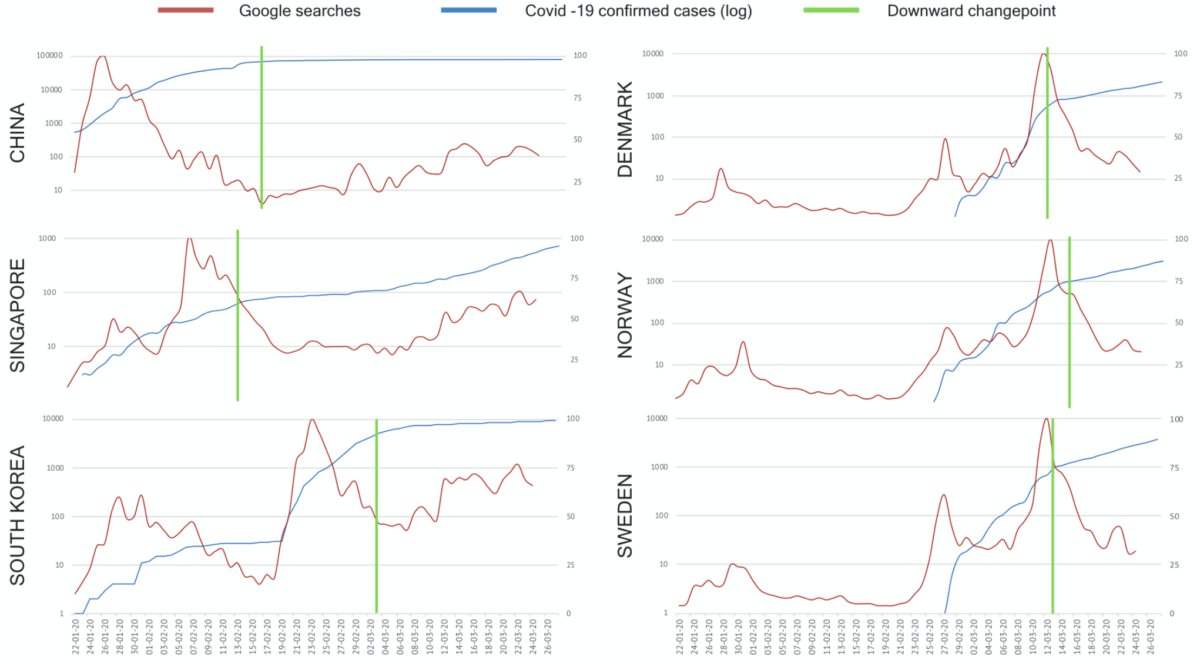
Based on these findings, we believe that Google search trends could reflect the quantity of information people are getting about the virus and the measures that they should adopt to fight it. We think that the former could lead to a shift in people’s behaviour and therefore prompt downward movement in the contagion trend. We illustrate that hypothetical process in the figure below:
Figure 2. How do Google searches relate to the decrease in the COVID-19 transmission trend?

The evidence: How the Google search boom was associated with prevention behaviours in Chile
It was not easy to test our hypothesis empirically, since the information peaks happened some time ago. We needed to find cases where the appropriate data – information on transmission-related social perceptions and behaviours in the period before and after a clear Google search peak – were collected coincidentally.
This occurred in Chile, where the consultancy firm Activa Research continually studied the country’s population behaviour and attitudes with regard to the coronavirus (here and here). It conducted two survey waves, just before and after the Google search peak in Chile, which enabled us to compare the two moments and reach the following conclusions.
First, along with this widespread process of information searching, there was a notable rise in citizen concern about the coronavirus. Before the peak, 37.3% of those surveyed said they were worried or very worried about the virus, and after the Google search peak, it soared to 87.5%.
Second, more people got informed about how to prevent the virus. The percentage of informed or very informed respondents increased from 67.1% to 90.8%. This progress was due to the growth in the number of highly informed people, which grew from 30.6% to 51.4%.
Third, there was a notable adoption of measures to prevent the contagion. More people reported washing their hands frequently with soap, refraining from kissing other people or touching their hands, avoiding sneezing on their hands, using alcohol gel, avoiding crowded places, wearing masks in public places, stopping touching their nose or eyes without washing hands, and avoiding the consumption of uncooked animals.
These changes in behaviours and attitudes were supported by a shift in spatial mobility patterns. In the COVID-19 Community Mobility Reports, Google published some general information on trends in Chile. In the very period when Google searches increased up until the peak in searches – from March 8 to March 16 – mobility decreased in places of retail and recreation (-73%), grocery and pharmacy (-55%), parks (-72%), transit stations (-64%), and work (-42%), while mobility in places of residence increased (+24%).
Figure 3. Changes in Chile’s mobility during the COVID-19 pandemic
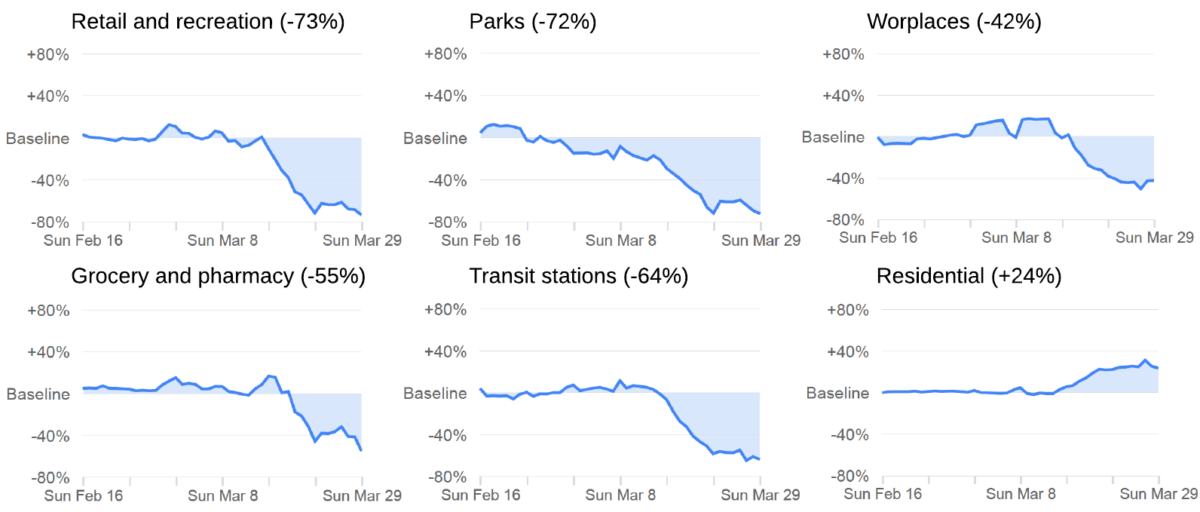
This evidence supports our hypothesis: the Google search peaks seem to indicate more than just an informational process. They also point to related social processes: people’s increased concern, knowledge dissemination about prevention and – a factor that is particularly relevant here – a social change in behaviours that promoted virus containment.
If that is true and was part of the process that the “recovering countries” experienced, then the obvious step is to wonder about the “in-process countries” – i.e. those that had not been able to control the virus contagion yet. What lessons were there for these countries?
What could we expect for the in-process countries?
Unfortunately, at the time of the analysis, lots of countries were still struggling with the COVID-19 contagion trend. This was the case for some Central European countries, such as Germany, Italy, and Spain, as well as the United States and others from Latin America, like Argentina, Brazil, Chile, and Mexico. The following graph portrays the transmission curve for each of those countries.
Figure 4. Evolution of confirmed cases of COVID-19, in-process countries (log)
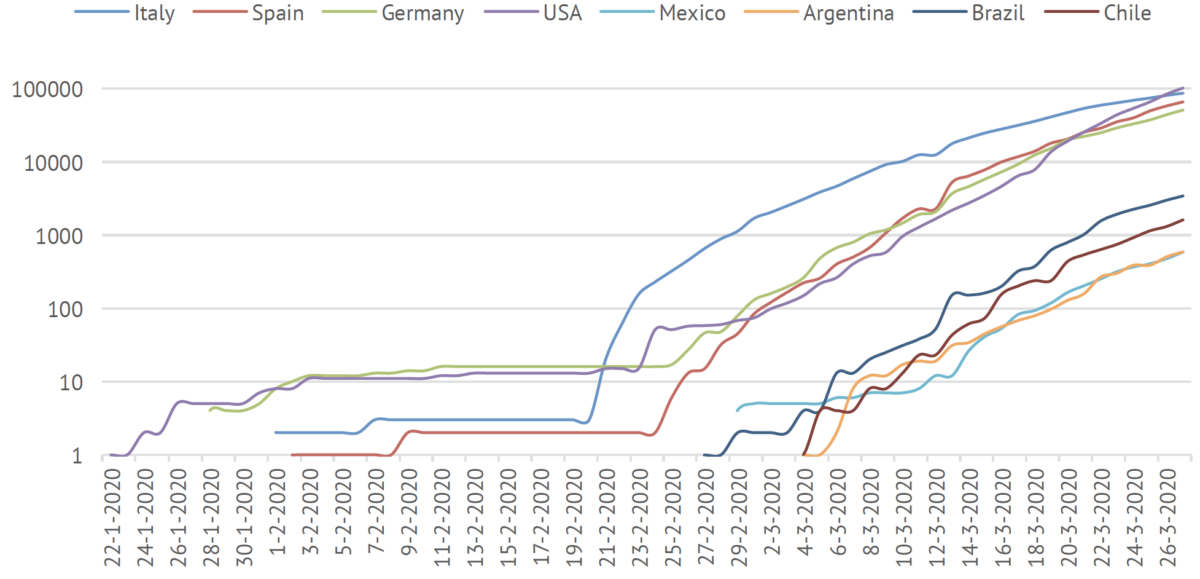
We already know that the recovering countries took 7 days on average to arrive at the downward changepoint of the infection after having reached a Google search peak. Had the in-process countries reached their Google search peak at the time of the analysis? The figure below shows the searches on Google related to the coronavirus in those territories.
Figure 5. Google searches related to COVID-19 in the in-process countries
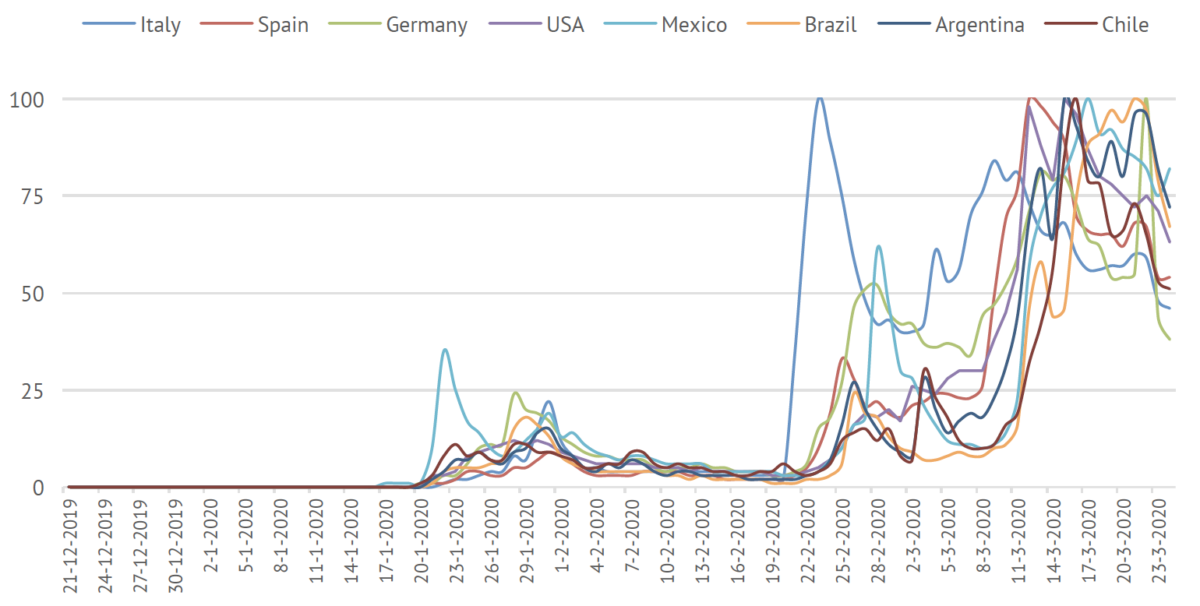
As you can see, except for the case of Italy – which we will discuss later – after March 12 the in-process countries began reaching their Google search peak on the “coronavirus” term. Based on this figure, we predicted in our discussion paper that some of these countries would also reach a downward changepoint in their transmission trend at some point between March 19 and April 5 (estimating the average response time). That seems to have happened in countries like Germany, Spain, Argentina and Chile.
But we also proposed that the speed and strength of the population information process would depend on many political variables and on the particular way in which the citizenry responded in each country. In some cases the information communicated was highly confusing or questionable, which could have diminished the positive effect of a Google search peak. A good illustration of the former would be the Italian case.
The exception that proves the rule: the case of Italy

Italy was one of the cases that, having reached a clear information saturation peak, had not been able to contain the virus spread by the end of March 2020, as the following figure illustrates.
Figure 6. Evolution of COVID-19 confirmed cases and Google searches, Italy
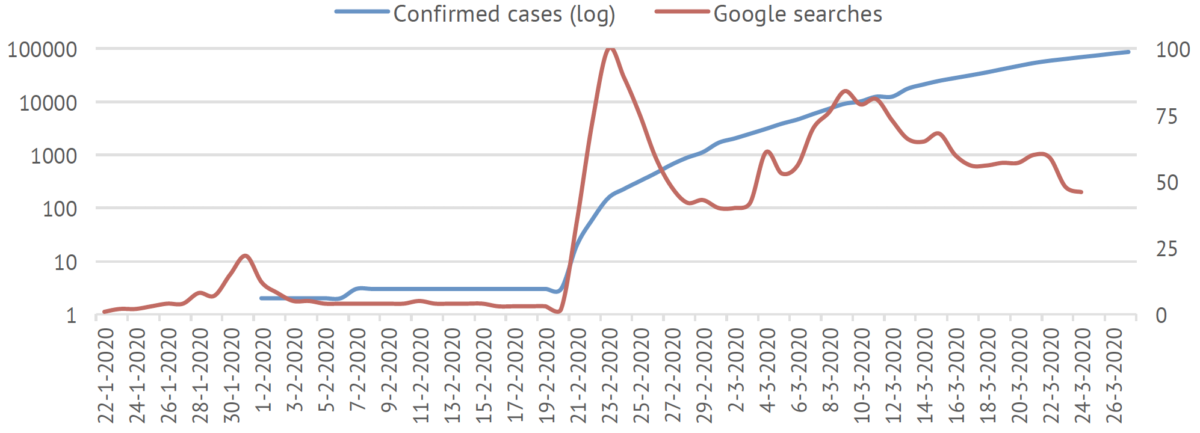
Although there were signs of moderate mitigation of the contagion – around February 24 – the change in trend was not as significant as in the recovering countries. The question, then, is why a developed country whose public health system was well prepared and whose prime minister, Giuseppe Conte, took lockdown measures starting on February 23 did not reach a clear downward changepoint when expected?
Some have claimed that Italy’s high proportion of people over 65 years-old – the second oldest population in the world after Japan’s – was the factor that increased contagion and death rates. Others say that the “tactile” Italian culture made it too difficult for Italians to avoid physical contact, promoting the virus spread. Both factors could certainly have affected this trend, but they are too stable to contribute to the understanding of rapid variations in transmission trends.
When managing a pandemic, politics and political communication matter
Despite Mr Conte’s statements, some Italian politicians strongly underestimated the disease, and that could have slowed down an information process that might otherwise have been beneficial in containing the contagion.
This can be illustrated by some examples, all of which took place on the same day, February 27, four days after Mr Conte’s interventions. To start with, Mr Nicola Zingaretti, president of the Lazio region (which includes Rome), posted a photo of his crowded after-work aperitivo, implying that the disease was not that bad. He subsequently became one of the active infected subjects. The second example relates to the country’s foreign minister, Luigi di Maio, who claimed: “In Italy, we went from the risk of an epidemic to an infodemic”, blaming the media coverage for generating unnecessary panic among the population. Last but not least, the mayor of Milan, Giuseppe Sala, launched the campaign “Italy doesn’t stop, Milan doesn’t stop”, reopening the famous Milanese cathedral, Il Duomo, and asserting that the lockdown measures were exaggerated. Almost two months later, we can see how unfortunate these declarations were.
An additional political factor that allowed the increase in the disease was the suspension of COVID-19 tests in asymptomatic Italians. The authorities disregarded the advice from Tedros Adhanom Ghebreyesus, the head of the World Health Organization (WHO): “Test, test, test. All countries should be able to test all suspected cases, they cannot fight this pandemic blindfolded”.
On balance, both the halting of COVID-19 testing as well as the reckless decisions and communications of some Italian authorities might have outweighed the precautionary attitude indicated by the Google search peak of February 23. Hence, policies and political communication matter. A lot.
Main findings
- Based on the cases we studied, we are confident that regardless of the culture, healthcare system, or geographic location in question, a Google search peak preceded the contagion downward changepoint in the recovering countries. These peaks even seemed to predict the containment of the contagion in the countries, although the speed and strength of the influence of this information on the population depends on many political and communication variables and on the way the citizenry responds in each country.
- Although it would be necessary to identify new cases to underscore this point, the Chilean case suggests that the big increase in Google searches is linked to an increase in people’s concern, in their management of information about the virus and in the development of preventive behaviours (including changes in mobility patterns). The joint manifestation of all these elements would explain their association with a greater containment of this pandemic.
- Our findings might have public policy and crisis management applications. The Google search peak could be used as a proxy for citizens’ concerns and their response level, giving some guidance to both policy- and decision-makers. Of course, it is not a very detailed indicator, but it is fast, cheap and already available for use by any government. Moreover, it can be used at a more detailed level, allowing the analysis of patterns in regions within countries.
- Today the world is facing an unprecedented crisis that is also challenging traditional methods of social research. Greater adoption of digital methods seems to be an appropriate response to this crisis. These methods are safer (in terms of preventing infection), faster, more accessible and much cheaper than traditional ones. However, we must be extremely cautious about protecting privacy rights. In the method proposed here, we do not see unethical procedures that transgress relevant privacy boundaries.
Carlos Cruz Infante is a sociologist with an MBA and is a former chief of strategic content of the General Secretariat of the Presidency of the Chilean Government. He now works as a consultant and independent researcher. He has given lectures in Italy about the MERCOSUR-European Union FTA, as well as about Latin America’s turmoil in 2019, and has advised the Inter-American Development Bank (IADB).
This post represents the view of the author and does not necessarily represent the view of the institute itself. For more information about the topics of these articles and associated research projects, please contact info@hiig.de.

You will receive our latest blog articles once a month in a newsletter.
Research issues in focus
Escaping the digitalisation backlog: data governance puts cities and municipalities in the digital fast lane
The Data Governance Guide empowers cities to develop data-driven services that serve citizens effectively.
Online echoes: the Tagesschau in Einfacher Sprache
How is the Tagesschau in Einfacher Sprache perceived? This analysis of Reddit comments reveals how the new simplified format news is discussed online.
Opportunities to combat loneliness: How care facilities are connecting neighborhoods
Can digital tools help combat loneliness in old age? Care facilities are rethinking their role as inclusive, connected places in the community.




